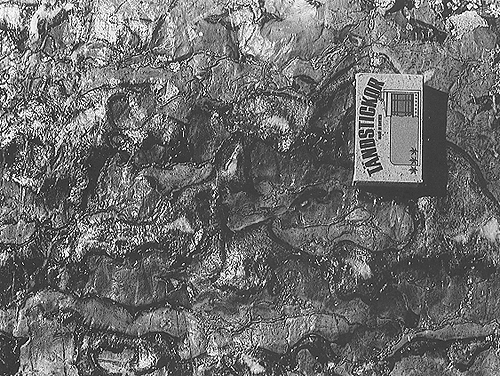
Stromatactis structure
Plate 168

Stromatactis structure
Plate 168
This structure is found in carbonate rocks, mostly of Paleozoic age, but a Recent analog has been reported from the Florida Channel. Its origin is not yet fully understood and has long been debated.
Stromatactis is the name given to irregularly shaped masses of sparry calcite (or sparite, made of clean, relatively large crystals) scattered in, or alternating with microcrystalline calcite (micrite). In the picture, micrite forms the darker mass. The contours of the sparite spots are sharp and jagged.
According to one of the most credited interpretations, the calcite crystals filled leaching vugs that originated in moundlike bodies of semilithified carbonate. More precisely, the mounds would have built up in shallow water by a steplike process, with alternating layers of loose sediment (carbonate mud) and crusts of early lithified mud. The fine carbonate particles were probably aggregated by some kind of microscopic organisms (algae, bacteria, or others). Later dissolution would have selectively removed the mud horizons. The crusts would have locally collapsed for lack of support, and this resulted in a series of irregularly distributed cavities. The last phase (the "seal") was represented by the filling of the cavities by chemical cement.
A Lower Devonian stromatactis-bearing carbonate mound from southern Sardinia.
| Photo: M. Gnoli et al. 1981. Neues Jahrbuch Geol. Paleont. Monatshefte H-6. |